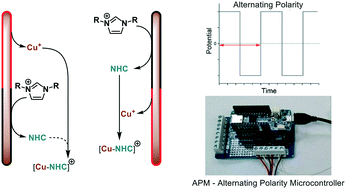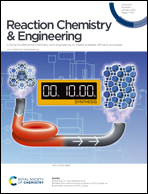Alternating polarity for enhanced electrochemical synthesis†
Abstract
Synthetic electrochemistry has recently become an exciting technology for chemical synthesis. The majority of reported syntheses use either constant current or constant potential, however a few use non-linear profiles – mostly alternating polarity – to maintain efficiency throughout the process, such as controlling deposits on electrodes or ensuring even use of electrodes. However, even though parameters that are associated with such profiles, such as the frequency, can have a major impact on the reaction outcome, they are often not investigated. Herein, we report the crucial impact that the applied frequency of the alternating polarity has on the observed reaction rate of Cu(I)–NHC complex formation and demonstrate that this can be manipulated to give enhanced yield that is stable over extended reaction times.

- This article is part of the themed collection: Welcoming our new Reaction Chemistry & Engineering Editorial Board members


 Please wait while we load your content...
Please wait while we load your content...